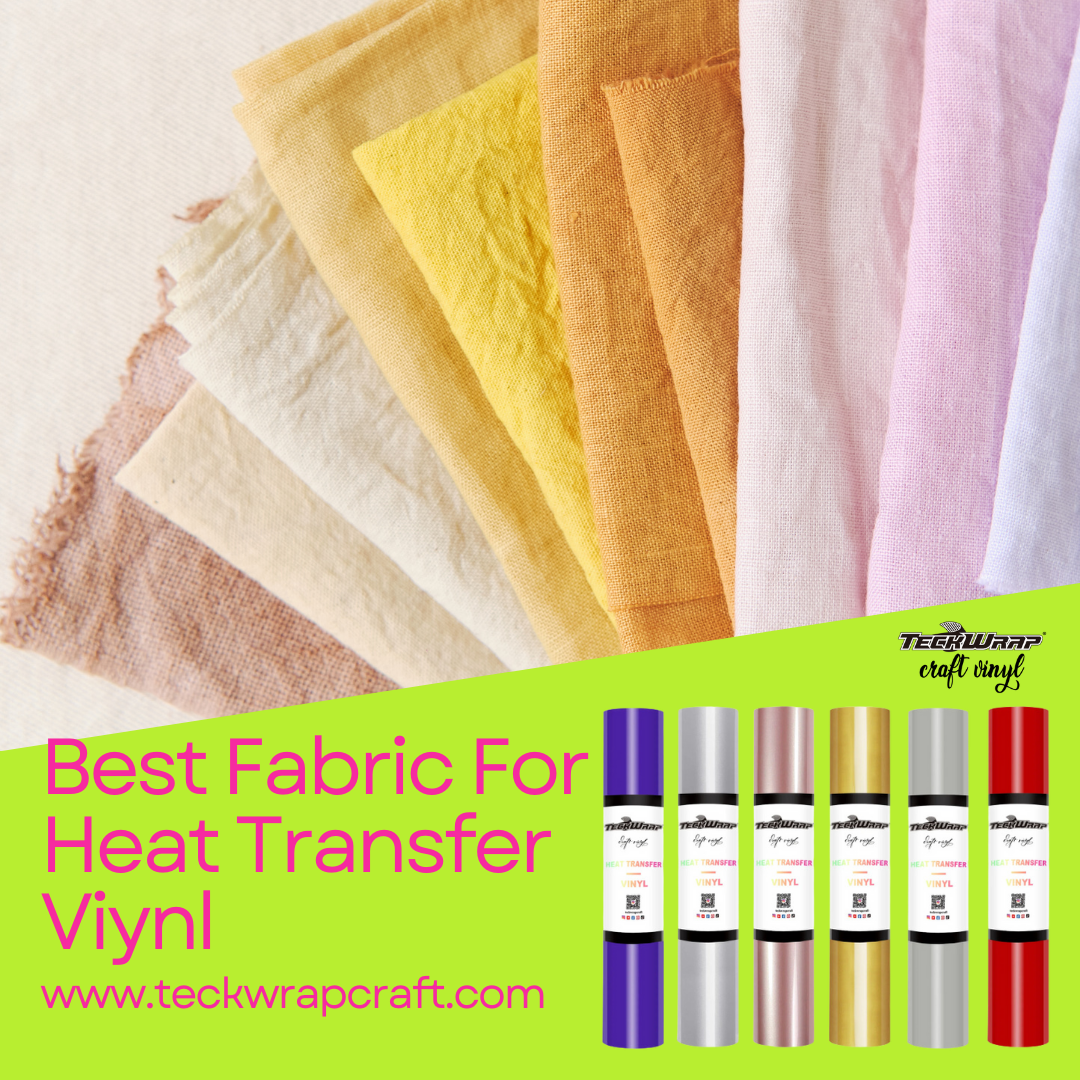Posted By TeckWrap Craft On August 15, 2023
How To Fix Heat Transfer Vinyl Mistakes?

Table Of Contents
- Common Heat Transfer Vinyl Mistakes
- Not Following Temperature And Time Instructions
- Not Applying Adequate Pressure
- Not Preparing The Fabric Properly
- Not Using The Heat Resistant Sheet
- Layering HTV With Different Properties
- Not Using A Flat Surface
- Forgetting The Final Press
- Washing Your Design Early
- Missing A Piece While Weeding
- Not Storing HTV Properly
- Buying Cheap Products
- 8 Ways To Fix HTV Mistakes
- 1. Identify The Mistake
- 2. Remove The Vinyl To Fix An Error
- 3. Use The Right Combination Of Heat And Pressure
- 4. Smooth Out Wrinkles And Bubbles
- 5. Cover With Additional HTV
- 6. Practice On Scrap Material
- 7. Use The Compatible Fabric
- 8. Store The Vinyl Properly When Not In Use
- What Is The Correct HTV Application Process?
- Frequently Asked Questions
With the rising popularity of DIY crafts, Heat Transfer Vinyl has become a household name. However, problems may arise and mishaps can occur during the transfer process, especially if you are a newbie. You may encounter wrinkled decals or the film might not adhere to the fabric properly. You can fix these heat transfer vinyl mistakes by adjusting temperature and pressure settings or gently peeling off the area where the error is made using a tweezer and correcting it.
This might seem overwhelming but do not worry! You just need to know a few tips and tricks to complete the procedure flawlessly. The fact is that the ease of application and variety HTV offers is second to none coupled with being an affordable way to embellish clothing and accessories. This blog post will help you cover up mistakes and avoid them in the future so keep reading!
Common Heat Transfer Vinyl Mistakes
During your crafting journey with heat transfer vinyl, here are some common mistakes you may encounter and why they might occur.

Not Following Temperature And Time Instructions
This is one of the most common mistakes that one might make. Due to this the heat transfer vinyl design may peel off or not adhere properly. It happens when you are not pressing your heat source on the design long enough or at a high enough temperature. Therefore, the heat-activated adhesive might not be hot enough to stick to the fabric.
Not Applying Adequate Pressure
Apart from time and temperature, pressure is also specified in the packaging of HTV. Some vinyl requires medium to high pressure while others require lower pressure. Make sure to check these instructions as not enough pressure will reduce the longevity of your project. Your HTV design might peel off sooner than expected. If you are using a heat press, you can adjust the pressure on your machine.
Not Preparing The Fabric Properly
This is also a common heat transfer vinyl mistake that one makes. Poor surface preparation can lead to inadequate adhesion and subsequent failure of the project. The surface should be clean and free of dirt, grease, and any other contaminants. It is better to wash the fabric, especially if you are using cotton, not only to clean it but also to ensure that it will not shrink once the HTV design is applied to it.

If the fabric will shrink, the HTV design will also shrink with it and look wrinkled and damaged. Also, pre-press your garment before the application of the decal. This will remove all traces of moisture from it that hinder the proper adhesion of HTV. Hence the fabric or any other surface such as wood or leather, should be perfectly clean, dry, and crease-free before you apply heat transfer vinyl to it.
Those who love to experiment and are transferring HTV design to wood will have to make sure that it is completely smooth and clean. You might have to sand it down to achieve this.
Not Using The Heat Resistant Sheet
This is another error one might make when working with heat transfer vinyl. Placing a Teflon sheet, parchment paper, or butcher paper is highly imperative for a number of reasons. It acts as a barrier between the heating element, such as an iron or a heat press, and the HTV. This helps protect the HTV from direct contact with the hot surface, preventing scorching or burning of the vinyl material.
Without a heat resistant sheet, there is a risk that the adhesive of the HTV might stick to the heating element, causing it to peel off from the fabric and resulting in an uneven application. Direct heat application may also lead to the HTV melting or warping, ruining the design.
Layering HTV With Different Properties
While layering is an excellent way to bring your creativity to life, it can be a tricky technique to master. This is due to the varying thickness of HTV materials and other properties like different temperatures, pressure as well as being a hot or cold peel.
Thicker heat transfer vinyl films like holographic ones are harder to apply and work best when applied directly to the garment. Be sure to check whether your preferred vinyl can be layered otherwise, the decal will come off after a few washes.

Not Using A Flat Surface
The first step when applying your design is to have a clean, dry, and flat surface. The reason is that a flat surface ensures that the pressure is evenly distributed on the design and fabric. If your garment has a zipper, button, or any other details, it disrupts the process and makes for an uneven design application. If this is happening, place a pressing pillow or towel underneath your fabric to raise the material to meet the details and create a flat surface.
Forgetting The Final Press
Another common reason your HTV design is likely to peel off is that you missed out on the final press. After your first press is done make sure you go over the entire design once with a butcher paper on top to press down any loose ends.
Washing Your Design Early
Typically, HTV designs require at least 24 to 48 hours to settle before you can wash them. This allows the HTV to cure and form a secure bond with the substrate. It also ensures that your design adheres properly and withstands washing and wearing later on. A few other tips for washing include avoiding machine washes, bleach, and softeners. When you plan on cleaning up your garment, make sure your design is inside out and wash it with cold water.

Missing A Piece While Weeding
This can occur more often than you expected especially if you mostly work with intricate designs. Weeding is tedious and time consuming and if there are a lot of small pieces to take out, chances are you might miss one. For this, you will have to reheat the design and remove the unwanted piece. A detailed explanation is given below.
Not Storing HTV Properly
If you frequently work with HTV, you must know that improper storage of vinyl rolls can lead to diminished performance of the film. This is crucial to maintain their quality and stability. When you do not take care of keeping the vinyl properly, it might lose its tack, fade or its surface finish might get damaged. Read on to find out about proper storage techniques.
Buying Cheap Products
We all love a good deal no matter what the merchandise, but it might cost us more in the long run. Do not settle for low-quality heat transfer vinyl no matter how less its price might be. At TeckWrap Craft, you get a bargain like no other. High quality HTV with refined manufacturing practices that keep up with industry standards is a guarantee from us.
Not only that, but we have an unrivaled variety of heat transfer vinyl ranging from trendy patterns to our beloved classic hues. You will find that our vinyl stands the test of time and promises to leave a lasting impression. Remember, the better the vinyl, the fewer mistakes you will encounter during the process.
8 Ways To Fix HTV Mistakes
Fixing heat transfer vinyl application errors can be a bit challenging, but with some patience and the right techniques, you can often salvage the project. Here are some steps you can take to address common HTV application errors:

1. Identify The Mistake
Before attempting any fix, closely examine the mistake to understand what went wrong. Common issues include wrinkles, bubbles, incomplete adherence, scorch marks, misalignment, spelling mistakes in words, forgetting to weed an extra piece from the design, and so on. See the kind of mistake you have made and rectify accordingly.
2. Remove The Vinyl To Fix An Error
If the mistake is significant like a spelling mistake or misplacement of layered designs or the heat transfer vinyl has not fully adhered yet, try to remove it from the surface. For misalignment issues, you may need to start over by removing the HTV completely. Then, realign the design correctly and reapply it.
You can use a weeding tool or tweezers to peel off the vinyl carefully. There are quite a few ways to remove HTV from a fabric. The easiest one is using a household iron.
Use A Household Iron Or Hair Dryer
If the HTV has already adhered, and you cannot remove it easily, try using a dry household iron or a hair dryer to gently warm the vinyl. This can help you peel off the HTV carefully. If you are using an iron, set it to high temperature and hold the shirt or your garment taut over it with the heat transfer vinyl decal facing up.
When you see that the vinyl is getting a bit wrinkled, start peeling it off with a tweezer. Be very careful as the vinyl and the shirt will be really hot. You can also use a hair dryer for this process but keep it at a low temperature setting.

Try Adhesive Removers
There are also commercial products available on the market like Vinyl Lettering Remover with which you can remove a specific part of the design only. These products can help dissolve the adhesive without damaging the fabric. You apply it on the inside of the shirt to break down the glue of the vinyl and take off the piece with a tweezer. Once the vinyl is off, you can reapply the design with fresh vinyl rectifying the mistake.
3. Use the Right Combination of Heat and Pressure
If the HTV is not adhering well, try reapplying heat and pressure. Peel off the carrier sheet a bit and if you see that the vinyl is coming off with it, place it back. Lay a Teflon sheet or parchment paper over the design and apply a heated iron or heat press for a few more seconds. You have to get the perfect combination of heat and pressure for the right amount of time for a perfect adherence of heat transfer vinyl to your fabric.
4. Smooth Out Wrinkles And Bubbles
If you have wrinkles or bubbles, gently lift the affected area and use a weeding tool to smooth it out. Apply heat and pressure again to ensure proper adhesion. You can also use a squeegee to smooth out bubbles.
Bubbles normally appear when you are layering a heat transfer vinyl design and you apply heat for a long time. Press for short amounts of time when transferring a multi-layered design.

5. Cover With Additional HTV
If you made small mistakes or you see scorch marks, you can cover them with additional HTV. Cut out a patch that matches the design and apply it over the affected area using the appropriate heat and pressure.
6. Practice On Scrap Material
Before attempting any fixes, it is a good idea to practice on scrap fabric to avoid making additional mistakes. It is recommended to do a test before working on the actual design.
7. Use The Compatible Fabric
For perfect HTV transfer results, it is imperative to know the best fabrics for heat transfer vinyl. You can easily apply it to cotton, polyester, poly/cotton blends, canvas, and denim. If you love to experiment, you can apply it to leather and wood as well. You will make minimal temperature and pressure settings mistakes if you use HTV with the fabrics it is compatible with.
8. Store The Vinyl Properly When Not In Use
It is important to store the heat transfer vinyl properly to maintain its longevity and performance. It should be kept in a cool, dry place away from direct sunlight, extreme temperatures, and high humidity. Fluctuations in temperature and moisture can negatively affect the adhesive and material quality.
Avoid folding the HTV film, especially along adhesive lines, as it can create permanent creases that might affect the application quality. If you have different colors or types of HTV, it's a good idea to separate them using sheets of parchment paper or plastic dividers to prevent color bleeding or adhesive transfer.

Keep track of your HTV inventory and usage. Using the oldest materials first, based on the purchase date, can help prevent waste due to films expiring before they are used. Periodically inspect your stored HTV for any signs of deterioration, such as changes in texture, discoloration, or loss of adhesion.
If you notice any issues, it's better to replace the material rather than risk using it for transfers. Consider using TeckWrap Craft vinyl roll storage to preserve your HTV.
What Is The Correct HTV Application Process?
Prevention is key, so be sure to follow proper application instructions and take your time during the process. Here is the procedure you should be following to avoid mistakes.

- First, decide the pattern you want to apply with HTV using design software. If you are using a cutting machine, you will have to import the design to its software eventually. Make sure to mirror the design before cutting, as you will be applying it face down.
- If you are using a cutting machine, place the HTV on the cutting mat, load it, and apply the right settings for your choice of heat transfer vinyl. If you are manually cutting, be sure to use heavy duty sharp scissors.
- Once the design is cut, weed out any excess vinyl to get the final design that you initially visualized. For this step, invest in good weeding tools so you do not disrupt your design. You can get a tweezer, weeder, or a weeding pen from the ‘Accessories’ section of our TeckWrap Craft website. Get the one you are most comfortable using.
- An important step is preparing the fabric that you are using to transfer your design. It should be washed and pre-pressed to dry up moisture and sort out wrinkles. Next, place the HTV design on it with the carrier sheet facing up. Position it as desired, making sure it is centered and straight.
- Cover the design and fabric with a Teflon sheet or parchment paper. If you are using a heat press, set the appropriate temperature and time according to the HTV manufacturer's instructions. If you are using a household iron, set it to the cotton/linen setting with no steam.
- Apply firm and even pressure to the entire design. When the time is up, allow the vinyl to cool for a few seconds then gently peel off the carrier sheet while it is still warm. If any part of the vinyl starts to lift, lay the carrier sheet back down and apply more heat and pressure. In the end, peel off the carrier sheet at an angle slowly from one corner.
- The last step is to do a final press over the design so that it adheres properly. Do not forget to put the parchment paper on top. Finally, your project is ready but be sure to wait 24 hours for the first wash.
Frequently Asked Questions
Enjoy An Error-Free Heat Transfer Vinyl Application!
With this set of instructions and tips to keep your HTV mistakes at bay, you can carry out your crafting projects perfectly with ease. As mentioned before, investing in quality vinyl and tools can greatly decrease the chances of mishaps as well as increase the durability of your designs.
You can find everything you need at TeckWrap Craft’s website. We offer an entire catalog of the best HTV for our ardent customers. We maintain the same premium quality across all our products and provide specific instructions for each category of heat transfer vinyl. Waste no time and place your order today!







